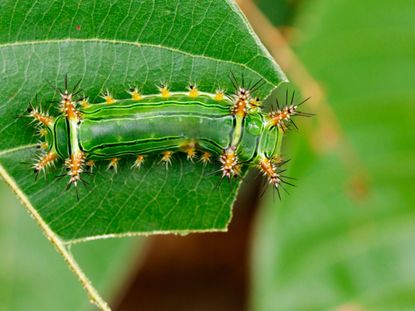Cup Moth Info - Learn About Gardening With Cup Moths


Cup moths are Australian insects that feed on eucalyptus foliage. Voracious feeders, a single cup moth caterpillar can make short work of an entire eucalyptus leaf, and a severe infestation can defoliate a tree. The tree generally recovers unless this happens several years in a row. For people sharing the garden with the mottled cup moth, or related species, it helps to have some cup moth info handy in order to fight off these little buggers.
What are Cup Moths?
The two most common types of cup moths are the mottled cup moth (Doratifera vulnerans) and the painted cup moth (Limacodes longerans). Cup moths usually produce two generations of offspring per year. The adult moths are brownish in color and emerge from their rounded or cup-shaped cocoons in late winter or summer. They soon set to work mating and laying eggs, and the caterpillars hatch in spring and fall. The caterpillar is the only life stage that causes damage to plants. The colorful, slug-like caterpillars don't have legs like other caterpillars, so they glide across the surface of the leaf. The fleshy protuberances on both sides of the body look fearsome, but they are harmless. The danger comes from rosettes of retractable spines at the front and tail end of the body. Cup moth caterpillars can have up to four sets of spines.
Gardening with Cup Moths
For those living in Australia or other areas where the insect is found, gardening with cup moths can be both disconcerting and somewhat unpleasant. Protect yourself with gloves and long sleeves when working around cup moth caterpillars in the garden. Brushing against a caterpillar causes a painful sting, which later turns to intense itching. Though temporary, the effects of the sting are very unpleasant.
Additional Cup Moth Info
All types of cup moths are susceptible to viruses that help keep the insects in check. In addition, they have a number of natural enemies that include parasitic wasps and flies, as well as biting midges. Birds sometimes eat the caterpillars too. Because of these natural controls, treating the insects is often unnecessary. If natural solutions aren't enough, however, spray the caterpillars with Dipel. This insecticide, which contains Bacillus thuringiensis, an organism that causes the caterpillar to sicken and die, is rapidly broken down by sunlight, so spray on a cloudy day or at night. This insecticide is a good choice because it kills caterpillars without harming other wildlife. Insecticides containing carbaryl are also effective, but they kill the natural predators as well as the cup moth caterpillars.
Gardening tips, videos, info and more delivered right to your inbox!
Sign up for the Gardening Know How newsletter today and receive a free download of our most popular eBook "How to Grow Delicious Tomatoes."

Jackie Carroll has written over 500 articles for Gardening Know How on a wide range of topics.
-
 Grow a Bathroom Oasis: 8 Best Bathroom Plants With No Light or Low Light
Grow a Bathroom Oasis: 8 Best Bathroom Plants With No Light or Low LightSome apartment dwellers grow the best bathroom plants with no light or low light. Read how one of our favorite plant lovers does it in the big city.
By Teo Spengler
-
 "My Worst Mistake" – Gardeners Share 10 Hard-Learned Lessons
"My Worst Mistake" – Gardeners Share 10 Hard-Learned LessonsGardeners never stop learning, and sometimes our mistakes are the best teachers. But why not save time and heartache by learning from other gardeners' failures?
By Melanie Griffiths